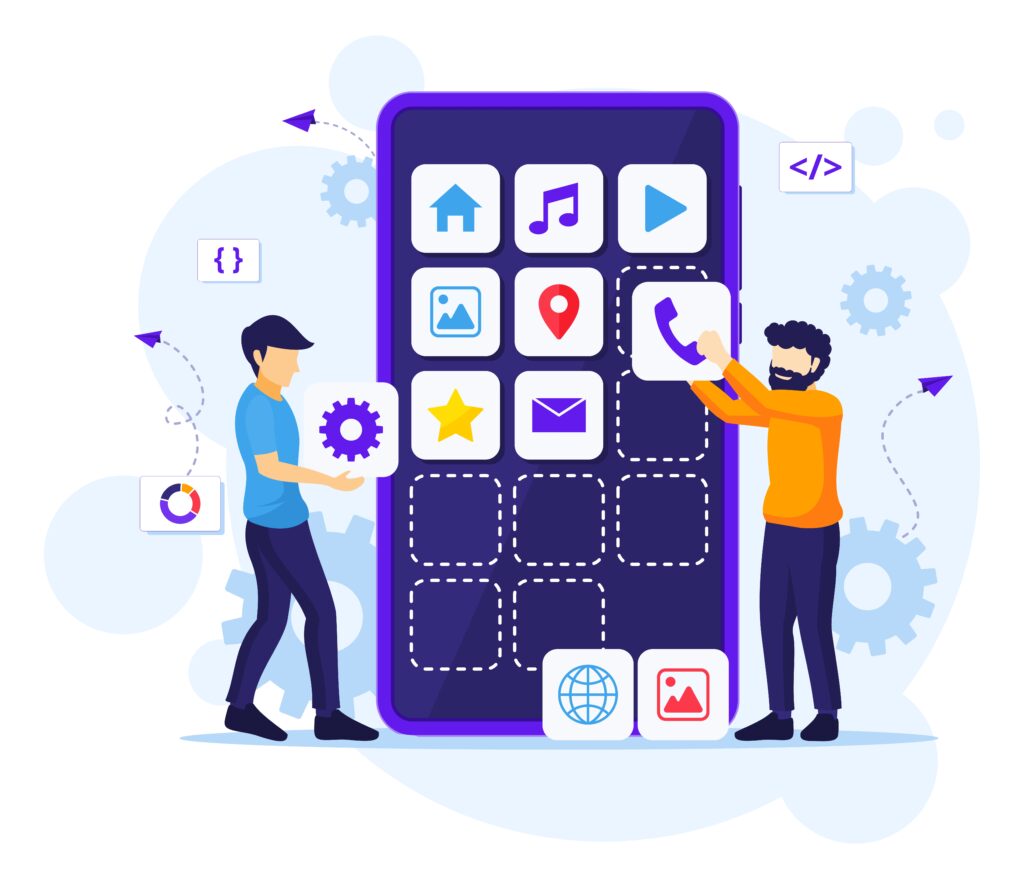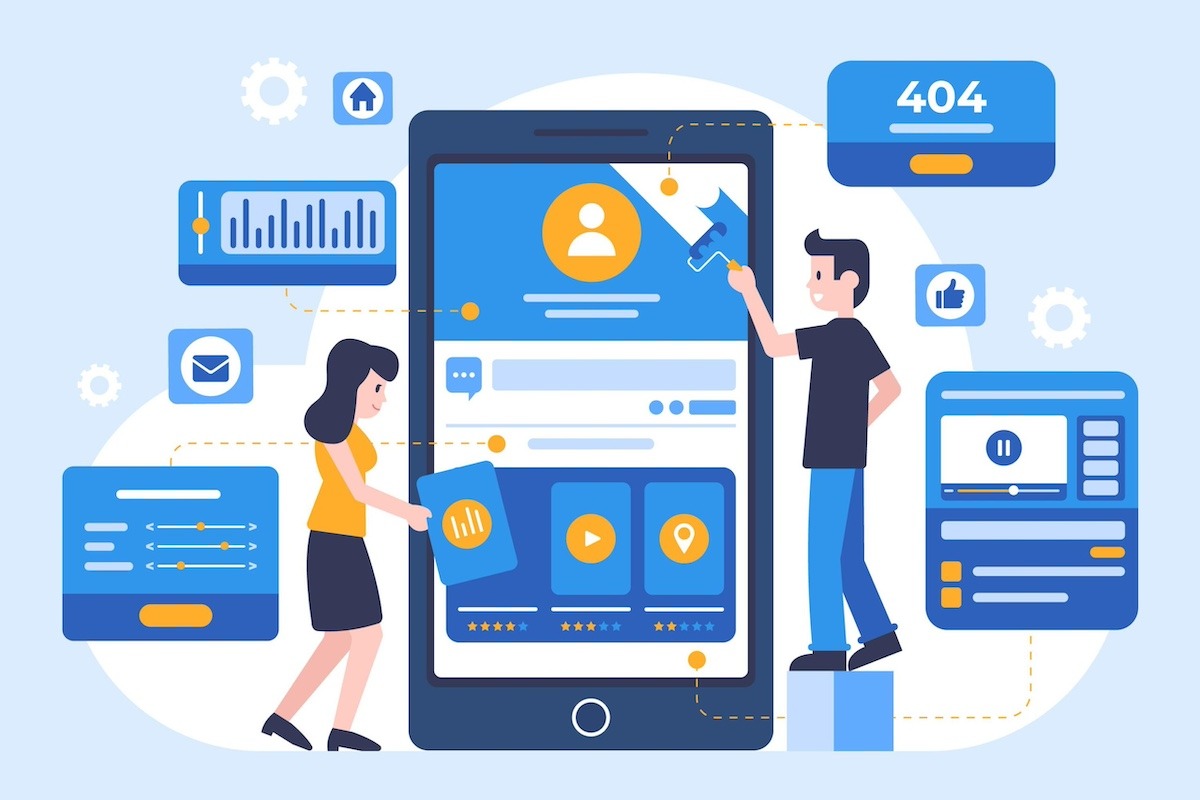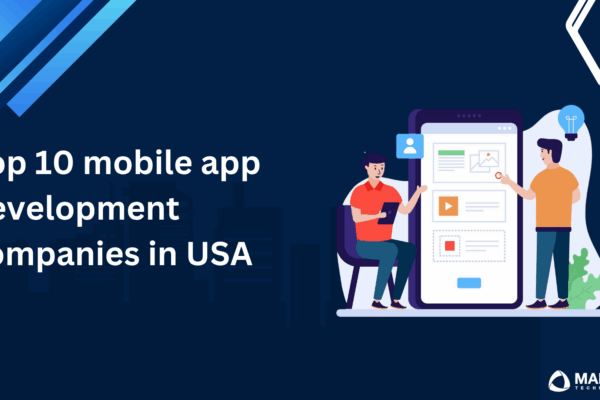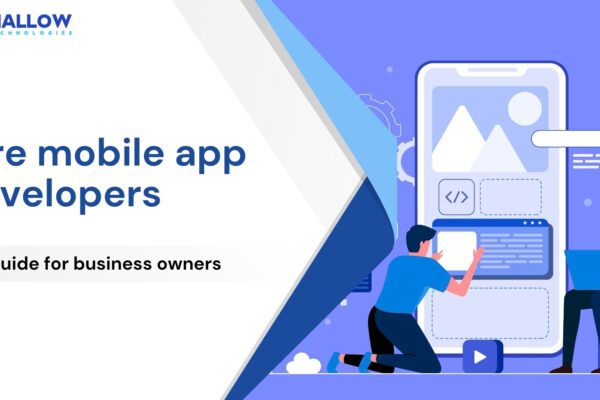In the world of mobile app development, one question often looms large: to go native or not? Native mobile app development, with its strengths and drawbacks, is a pivotal crossroads every developer and entrepreneur must explore.
With a track record of delivering cutting-edge solutions to diverse clients across various industries, we at Mallow possess extensive experience in building native and hybrid mobile applications. Our team of developers has honed their skills over years of crafting mobile applications. This firsthand experience equips us with unparalleled insights into the pros and cons of building mobile applications.
After diving into this article, you can uncover the pros and cons that shape the future of your applications. You will embark on a journey to demystify the magic behind building applications natively, helping you make informed choices that propel your mobile endeavours to greater heights.
What is Native mobile application development?
Native mobile application development refers to the process of creating mobile applications specifically designed to run on a particular mobile operating system (OS) or platform. Native apps are developed using platform-specific programming languages and tools, such as Java or Kotlin for Android and Objective-C or Swift for iOS.
While there are other mobile platforms like Windows, they are not considered feasible options due to the dominance of iOS and Android in the market. These apps are optimised to take full advantage of the features and capabilities of a mobile device and its OS.

Below is a table that categorises types of applications into small, medium, and large, including details about how each can be handled in native application development:
| Size of the application | Type of domain | Handling in Native application development |
| Small | To-Do list application | A small to-do list application can benefit from Native development by offering a responsive and smooth user interface, quick task updates, and integration with device reminders. |
| Calculator application | Native development ensures fast calculations and a familiar user experience. Access to device features can enhance functionality, such as voice input or scanning input via camera. | |
| Flashlight application | A simple flashlight application can be built natively for quick access to the device’s flashlight hardware, ensuring optimal performance and user experience. | |
| Medium | Restaurant Finder application | For a medium-sized restaurant finder application, Native development allows integration with GPS for precise location-based services, user reviews, and real-time restaurant updates. |
| Budget tracking application | Native applications excel in handling financial data securely. A budget tracking application can leverage native security features, offline access, and push notifications for alerts and updates. | |
| News aggregator application | A news aggregator application can use native development to deliver a smooth and responsive reading experience, offline article caching, and personalised push notifications for breaking news. | |
| Large | E-commerce marketplace | A large e-commerce marketplace benefits from native development to ensure fast and secure transactions, robust search capabilities, and personalised user experiences. |
| Social media platform | Native applications provide the speed and responsiveness required for social media interactions. Features like live streaming, real-time notifications, and AR filters are best achieved natively. | |
| Online banking application | Security is paramount in online banking. Native development offers a high level of security, smooth transaction processing, and integration with biometric authentication for user trust. |
What are the pros and cons of Native application development?
Benefits of Native application development
1.
Performance and speed
- Native applications are optimised for a specific platform, allowing them to take full advantage of the underlying hardware and software. This optimisation results in faster load times, smoother animations, and overall superior performance.
- This advantage is especially crucial for applications that demand real-time interactions, heavy data processing, or high graphical performance, such as real-time GPS based tracking applications and multimedia applications. Research published in MDPI Energy journal has shown that native applications demonstrate superior performance in sensor data-driven applications, particularly those utilizing Bluetooth Low Energy (BLE) and Wi-Fi communication architectures, making them the preferred choice for IoT and real-time monitoring applications.
2.
Access to device features
- Native applications have direct access to a wide range of device-specific features and APIs. This means they can seamlessly integrate with functionalities like the camera, GPS, accelerometers, microphones, and more.
- Leveraging these features enables developers to create feature-rich and interactive experiences that wouldn’t be easily achievable in web or cross-platform applications.
3.
Optimised for the operating system (OS)
- Native applications are tailor-made for a particular OS, whether it’s Android or iOS. This approach ensures that they are fully compatible with the OS, resulting in a seamless and hassle-free user experience.
- Furthermore, native applications have the capability to leverage the most recent OS features and updates, ensuring that the application remains up-to-date and competitive.
4.
High-quality user experience
- Native applications adhere to the design guidelines and standards of their respective platforms. As a result, users are treated to a consistent and intuitive user interface, leading to higher user satisfaction and engagement.
- Due to the meticulous construction and seamless flow of native components, applications developed using these components exhibit a fluid and responsive nature. This enhances the overall user experience, making native applications a preferred option for businesses seeking to make a lasting impression on their audience.
5.
Security
- Native applications often benefit from robust security features provided by the OS. Because it includes data encryption, secured APIs, secured authentication, Code Obfuscation, secure key storage, etc. This makes them more secure and resilient to threats, which is vital for applications that handle sensitive data, such as financial or healthcare applications.
6.
Development and community support
- Native application development enjoys strong support from the platform providers (Google for Android, Apple for iOS). This support includes comprehensive documentation, development tools, and libraries, making it easier for developers to create high-quality applications. You can also make the best use of the technical support and informative educational sessions provided by the platforms, to get deeper insights.
- Native application development enjoys robust community support with active communities for popular platforms like iOS and Android. Developers can find a wealth of resources, libraries, and forums where they can seek help, share knowledge, and collaborate on solving challenges specific to each platform.
Drawbacks of Native application development
1.
Development time and cost
- Native application development can be time-consuming and costly because it involves creating separate codebases for each target platform (e.g., Android and iOS).
- Maintaining multiple codebases, development environments, and skill sets can significantly increase development expenses and project timelines.
- Developing native applications for multiple platforms often results in a longer time-to-market compared to cross-platform or web-based solutions.
- You need to be extra cautious with the business logic since you need to implement it twice in the different platforms and also do the testing twice
2.
Maintenance challenges
- Native applications require separate maintenance efforts for each platform. When updates or bug fixes are needed, developers must address them individually for each version of the application.
- This can lead to challenges in synchronising features and ensuring consistent user experiences across different platforms.
3.
Specialised skill sets
- Native application development requires specialised knowledge and skill sets in platform-specific programming languages and tools (e.g., Java/Kotlin for Android, Objective-C / Swift for iOS,).
- Apple and Google continue releasing new/changing patterns (SwiftUI and Jetpack) and introduce new technologies (AI&ML) frequently. This means that businesses may need to hire or train developers with expertise in these technologies, which can be a challenge.
When should I go with Native mobile application development?
Deciding when to opt for native mobile application development is a critical choice that depends on various factors. Here’s a breakdown of these factors and some real-world examples to illustrate them:
- You are planning for a big project with larger scopes
Native development is ideal for larger projects with extensive feature requirements and budgets to match. It’s well-suited for complex applications, such as social media platforms, e-commerce marketplaces, or video streaming services, where performance and user experience are paramount.
- When you own platform-specific target audience and market
If your target audience predominantly uses a specific platform (iOS or Android), native development ensures the best user experience and can help you tap into the platform’s user base effectively. For instance, if you’re building a fitness application targeting health-conscious iOS users, native development on iOS would be the primary choice.
- If you already own the development team expertise
When your development team possesses expertise in platform-specific programming languages (Java/Kotlin for Android Objective-C/Swift for iOS), native development is a logical choice. Native development allows skilled developers to fully leverage the platform’s capabilities for optimal performance and user experience.
- Need for device-specific features
Applications that require extensive access to device-specific features, such as GPS navigation applications, augmented reality (AR) applications, or camera-intensive applications like Snapchat, benefit from native development. Native applications have the closest integration with these features, ensuring seamless functionality.
- Long-term goals and maintenance
If your long-term plans involve continuous updates, scalability, and robust maintenance, native development is a solid choice. For instance, banking applications or enterprise software that must evolve with changing security protocols and regulations benefit from native development’s flexibility and security.
Alternatives to Native development
By now, you’ve gained a comprehensive understanding of what native application development entails, including its advantages, disadvantages, and when it’s the ideal choice for your application.
However, making an informed decision in today’s diverse tech landscape is not solely about understanding native development. The global mobile application market, valued at USD 252.89 billion in 2023 and projected to grow at a compound annual growth rate (CAGR) of 14.3% from 2024 to 2030, encompasses applications across various development approaches and sectors.
These comparisons with various alternatives offer a holistic view, empowering you to choose the best-suited option for your specific project. Whether you opt for cross-platform frameworks, web-based solutions, or other innovative approaches, having this complete picture ensures that your decision aligns precisely with your project’s requirements, goals, and constraints.
Hybrid and Progressive Web Applications (PWAs) have emerged as compelling alternatives to traditional native application development. Hybrid apps combine elements of both web and native technologies, allowing developers to write a single codebase that can run on multiple platforms. This approach leverages web technologies like HTML, CSS, and JavaScript, wrapped within a native container for access to device features. Hybrid apps are cost-effective and offer cross-platform compatibility, making them a practical choice for many organizations. On the other hand, PWAs are web applications that offer a native app-like experience within a web browser. They are built using standard web technologies and can be accessed through URLs without the need for app store downloads or installations. Check out this article on Pros and cons of Native vs Hybrid vs Progressive web applications for detailed insights on which option would be ideal for building your application.
Still not sure about from where you need to take your next step? Feel free to reach out to our team.
Your queries, our answers
Mobile application development involves creating software applications designed to run on mobile devices like smartphones and tablets. These apps can be native (built specifically for iOS or Android), cross-platform (designed to work on multiple platforms), or hybrid (combining elements of both).
Our mobile app development process includes the following stages: requirement gathering and analysis, design and prototyping, development and coding, testing and quality assurance, deployment, and post-launch support. Each stage is crucial to delivering a high-quality application.
To gain deeper insights into the experience of working on a mobile project with Mallow, explore more details here.
The choice between native and cross-platform development depends on your project’s goals, budget, and target audience. Native apps offer better performance and a more tailored user experience, while cross-platform apps allow for faster development and lower costs by using a single codebase for multiple platforms. For a detailed comparison of Native vs. Hybrid development, explore our comprehensive analysis to help you make an informed choice.
Mallow develops mobile apps for iOS, Android, and cross-platform solutions. We use the latest technologies and frameworks to ensure your app performs optimally on the platforms that matter most to your users.
Choosing the right features for your mobile app depends on understanding your target audience, business goals, and budget. We work closely with you to prioritize features that will provide the most value to your users and align with your business objectives.
At Mallow, we offer ongoing app maintenance and updates as part of our post-launch services. This includes regular updates to improve performance, add new features, and ensure compatibility with the latest operating systems. For more details, get in touch with our team.
Yes, Mallow assists with the entire app store submission process, including meeting the guidelines for Apple’s App Store and Google Play. We ensure your app is ready for submission and provide support to help it get approved.
Mallow uses a variety of technologies and frameworks for mobile app development, including Swift and Objective-C for iOS, Kotlin and Java for Android, and React Native and Flutter for cross-platform development. Our technology choices are driven by the specific needs of your project.
Our testing process includes functional testing, performance testing, security testing, usability testing, and compatibility testing across different devices and operating systems. We ensure your app is bug-free and performs optimally before it goes live.
The cost of developing a mobile app depends on several factors, including the app’s complexity, features, platform (iOS, Android, or both), and the development team’s expertise. Costs can range from $10,000 to $150,000 or more. To know more, check out how much it costs to work on a mobile project with us.
The development timeline for a mobile app varies depending on the complexity of the project. A basic app may take 2-4 months to develop, while a more complex app with advanced features can take 6-12 months or longer.
Choosing the right features for your mobile app depends on understanding your target audience, business goals, and budget. We work closely with you to prioritize features that will provide the most value to your users and align with your business objectives.
Yes, Mallow offers comprehensive post-launch support, including monitoring, updates, bug fixes, and enhancements. We ensure your app remains up-to-date and continues to perform well after it’s launched.
A mobile app can enhance customer engagement, increase brand visibility, provide better service through personalized experiences, and create new revenue streams. It also allows you to reach a broader audience by making your services more accessible on mobile devices.
Getting started with Mallow is easy! Simply reach out to us to discuss your project. We’ll work with you to understand your goals, define your requirements, and create a development plan that meets your needs. Let’s bring your mobile app idea to life!.
Security is a top priority at Mallow. We implement advanced security measures, including encryption, secure authentication, and regular security audits, to protect your app from potential threats and ensure data integrity.
To learn more about how we handle and implement these security measures, check out more details here.
Author
Yogesh Murugesh
Yogesh is an accomplished Senior Technical Lead at Mallow, boasting over 11 years of invaluable expertise in the realm of application development. With an extensive background spanning diverse domains, he has consistently delivered applications of the highest calibre. Yogesh's commitment to quality and excellence shines through in every project he undertakes. His career journey is marked by a proven track record of successfully crafting applications that not only meet but often exceed industry standards. His ability to navigate through various domains showcases his adaptability and keen problem-solving skills. Yogesh's contributions have consistently played a pivotal role in driving technological innovation and advancement within his field. Beyond his professional pursuits, Yogesh finds solace and joy in various activities. An ardent cricket enthusiast, he embraces the team spirit and strategic thinking that the sport demands. During leisure moments, he indulges in watching movies, allowing himself to be captivated by different narratives and genres. Moreover, Yogesh cherishes quality time with his child, relishing the role of a devoted parent.



